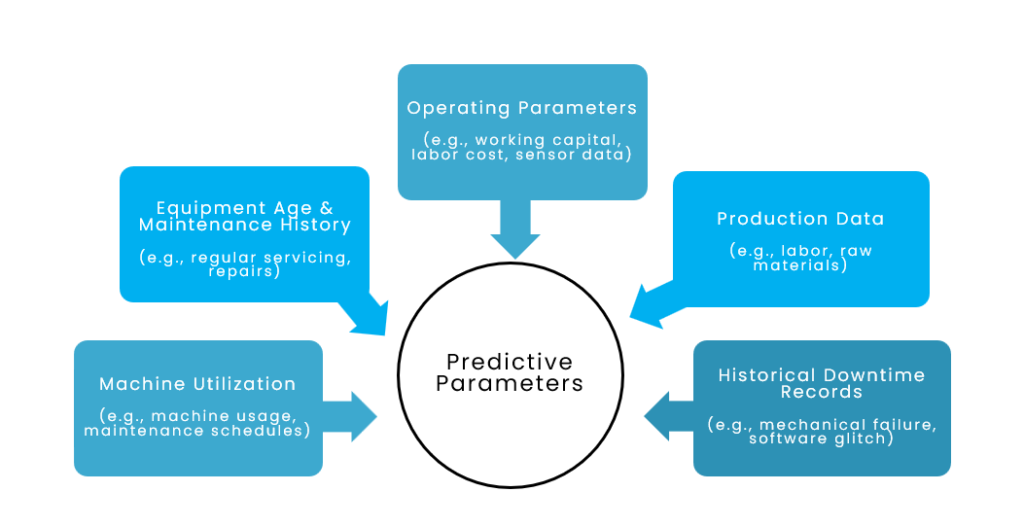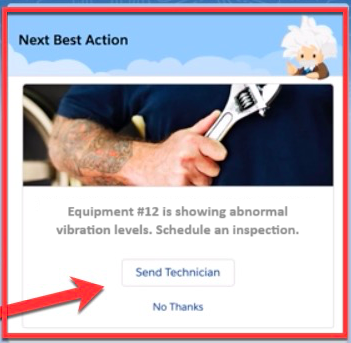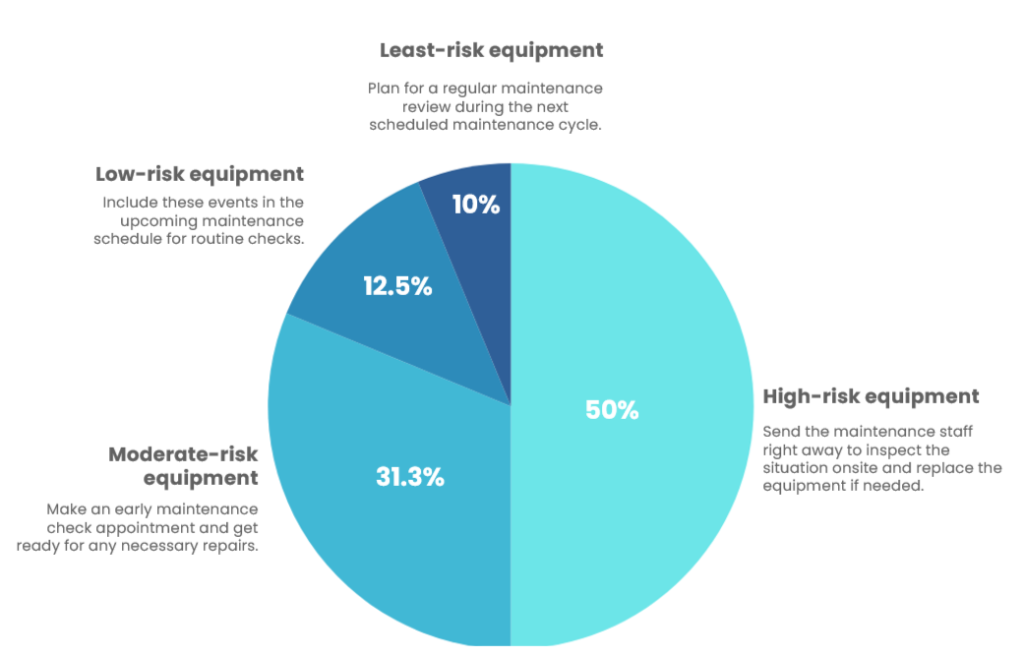Many manufacturing organizations experience equipment downtime on a regular basis. Not taking care of it properly can hurt a business’s reputation, make it less effective, and raise costs, among other things. It negatively impacts business operations.
Unplanned equipment downtime can arise from malfunctions, material complications, or even a scarcity of operators. In turn, this impacts the operational efficiency of manufacturing processes. So, how can we address that?
This is where Salesforce Einstein AI comes in handy. It can help you predict equipment failures beforehand and give preventive maintenance alerts to minimize downtime.
In this blog, we will understand how exactly, through a real user story. We will see how with the right Salesforce Einstein implementation, a manufacturing company minimized equipment downtime.
How HermesDrive, a Manufacturing Company Minimized Downtime Leveraging AI?
HermesDrive Automotive Pvt. Ltd., a renowned automobile manufacturer, struggled with unforeseen equipment downtime. The company used Salesforce Field Service to streamline its manufacturing operations, which proved to be instrumental. But these unplanned downtime issues disrupted their production operations, causing delays, lower productivity, and excessive labor expenses.
What is Unplanned Downtime?
The term “unplanned downtime” in operation occurs when a machine is unexpectedly not operational due to unforeseen circumstances. Common causes of this issue include equipment failure, operator error, or issues with stock or supplies. These unplanned downtime periods can result in large production and financial losses and are frequently more disruptive as compared to planned downtimes.
Calculation of the Cost of Unplanned Equipment Downtime
Later, the team calculated the exact cost of downtime to get a clear picture of the impact downtime was having on their operations. The high downtime percentage translated into substantial financial losses.
Time equipment is down/Planned operating time * 100 = Downtime %
The high cost of unplanned equipment downtime resulted in disappointed customers, damaged reputation, business Loss, and data issues.
Later, the company established an analytical team to assess the financial implications of unforeseen equipment downtime.
What Caused Unplanned Equipment Downtime?
HermesDrive Automotive identified four major causes of equipment downtime and how it impacted the operational efficiency of the manufacturing processes.
- Inadequate Maintenance: HermesDrive Automotive experienced repeated shutdowns due to inadequate equipment maintenance. The lack of a dependable system for tracking maintenance records increased this issue by increasing the likelihood of equipment failure.
- Hardware Failures: Another challenge emerged in the form of hardware failures. Components like sensors, fans, belts, and pumps would malfunction, bringing operations to a standstill. The absence of timely access to experienced staff and replacement components caused the service disruption.
- Late Delivery of Materials: HermesDrive experienced delays in material delivery, a frequent issue in manufacturing. Any delay in acquiring critical supplies meant production would halt, emphasizing the need for tighter control over production and supply schedules.
- Human Errors: Human error proved to be another source of production downtime. Whatever the reason, mistakes on the production line, slow shift changes, or employees calling for leave without warning, these problems often caused unplanned breaks and big delays in production.
Why HermesDrive Chose Salesforce Einstein?
HermesDrive Automotives could effectively manage its day-to-day tasks, but it lacked the capability to predict instances of unplanned equipment downtime. Here’s how HermesDrive overcame this issue:
Step 1: Analyzing the Problem Statement
Frequent shutdowns disrupted operations, and the company lacked a mechanism to handle unplanned downtime effectively. An analytical team assessed the financial impact and realized that simple maintenance checks weren’t sufficient.
Step 2: The Root-Cause Analysis
This analysis revealed the need to predict equipment health proactively. HermesDrive researched AI solutions and discovered Salesforce Einstein’s capabilities, including predictive analytics.
Step 3: Getting the Expert Consultation
The team consulted AI experts and Salesforce consultants (like AblyPro). They explored customizing Salesforce Einstein with Salesforce Service Cloud to meet their unique manufacturing needs.
Step 4: Proof of Concept (PoC)
Using historical data from Salesforce Field Service reports, they created predictive models. Einstein identified defective patterns, predicted demand fluctuations, and recommended optimal maintenance schedules. The team recognized the potential impact on efficiency and cost savings.
Based on the PoC results, HermesDrive implemented Salesforce Einstein to streamline field service operations. In addition, with the right implementation of Salesforce Einstein on top of Salesforce Field Service, the company was focused to overcome the issue of equipment downtime. Let’s understand how it works.
The Working Model of Salesforce Einstein
1. Predictive Parameters
The Salesforce Einstein Model analyzes a range of input variables tailored to the issue of unplanned equipment downtime in manufacturing. These variables may include:

2. Analysis of Data
Salesforce Einstein uses advanced analytics to analyze the input variables and identify patterns of potential equipment downtime. By leveraging historical data and real-time monitoring, Einstein generates insights into the factors contributing to downtime and their root causes.
3. Predictions and Alerts
Based on the analysis, Salesforce Einstein generates predictions and alerts to proactively manage unplanned equipment downtime. These predictions may include:
- Early Warning Signs of Equipment Failures
- Schedule Planned Downtime
- Get Maintenance Recommendations
- Plan for Proactive Resource Allocation
Step-by-Step Approach to Leverage Salesforce Einstein
In this section, we’ll explore how HermesDrive Automotive utilized Salesforce Einstein to effectively tackle the issue of unexpected equipment downtime. Let’s understand the detailed step-by-step approach they took to address this challenge head-on!
1. Data Collection and Preparation
HermesDrive collects relevant data from Salesforce Field Service reports and various other sources:
- Maintenance logs: Maintenance logs: These are documented records of previous instances of equipment failures, repairs, and maintenance tasks.
- Sensor data: Equipment sensors collect data in real time, including readings of variables like temperature, vibration, and pressure.
- Usage patterns: These refer to the frequency at which each piece of equipment is utilized.
- They organize and clean this data to create a comprehensive dataset to generate predictions.
2. Leverage Predictive AI
HermesDrive leverages Salesforce Einstein’s Predictive AI capabilities to generate predictive scores:
- High-risk Equipment: 80% to 90% probability of failure. These are almost certain to fail and should be monitored closely or replaced.
- Moderate-risk Equipment: 50% to 79% probability of failure. These have a significant risk of failing and require regular checks and maintenance.
- Low-risk Equipment: 20% to 49% probability of failure. These are less likely to fail but should still be under occasional observation.
- Least-risk Equipment: 10% to 19% probability of failure. These are unlikely to fail and can be checked less frequently.
- Minimal-risk Equipment: 1% to 9% probability of failure. These have a very low chance of failure and are the most reliable.
3. Real-time Monitoring and Alerts
As equipment operates, HermesDrive continuously monitors sensor data. When a piece of equipment approaches the predefined failure threshold, the system triggers alerts:
- The maintenance team receives notifications.
- Work orders are automatically generated for proactive maintenance.
4. Generative AI for Maintenance Recommendations
HermesDrive uses Einstein Next Best Action to create customized maintenance recommendations.
For example: “Equipment #1234 is showing abnormal vibration levels. Schedule a thorough inspection and lubrication.”

Here are customized maintenance recommendations for equipment based on risk probability:

5. The Results:
- Reduced Downtime: By addressing issues proactively, equipment downtime decreases significantly.
- Cost Savings: Timely maintenance reduces emergency repair costs.
- Improved Efficiency: Production lines run smoothly, leading to increased revenue.
- Customer Satisfaction: Fewer delays mean happier customers.
How a Reliable Salesforce Consultant Makes a Difference?
AI implementation is a multifaceted journey that demands a strategic roadmap tailored to your business objectives. This is where the expertise of a trusted Salesforce consultant, such as AblyPro, becomes invaluable. We specialize in bridging the gap between your vision and reality through comprehensive:
- Salesforce Einstein Implementation Services: AblyPro understands that every service business has unique needs. That’s why their Salesforce Einstein implementation services start with a deep dive into your company’s specific goals and challenges. Our team ensures a smooth and efficient implementation of Salesforce Einstein within your organization’s existing Salesforce infrastructure.
- Salesforce Einstein Managed Services: We provide ongoing support and optimization. This includes proactive monitoring, performance analysis, and adjustments to keep your AI running at peak efficiency. With our expert guidance, service businesses can continuously leverage the latest advancements in Salesforce Einstein to streamline processes, anticipate customer needs, and achieve superior results.
The Bottom Line
Integrating AI into manufacturing processes provides cost savings and prevents downtime. Utilizing tools such as Salesforce Einstein, predictive analytics is able to forecast equipment malfunctions, minimizing disruptions. Timely action is facilitated by proactive notifications, leading to the optimization of operations. Leveraging AI technology enhances decision-making, raising output and raising customer happiness. For operational excellence and resilience to guarantee sustainability and competitiveness, manufacturing industries require AI.
FAQs
Equipment downtime can be extremely costly for manufacturing companies because they can lose production capacity, take longer to fill orders, and make customers less satisfied. Loss of revenue, higher maintenance costs, and possible penalties for missing supply deadlines are all costs that come with downtime.
You can contact trusted Salesforce consultants, such as AblyPro that plays a crucial role in implementing and maximizing the power of Salesforce Einstein for enterprises. At AblyPro, we understand your business needs and provide customized AI solutions accordingly. We don’t just implement Salesforce Einstein but also track progress post-implementation. Our experts analyze feedback, monitor performance, and recommend adjustments. This iterative approach ensures that enterprises continually enhance their AI-driven processes.
Maintenance staff are empowered by Salesforce Einstein, not replaced. Einstein organizes maintenance activities with equipment failure predictions, allowing your team to focus on crucial fixes before breakdowns. Avoiding emergency repairs and freeing up time for preventative maintenance decreases your team’s workload.
Author

Global COO, AblyPro

For 20 years, Neeraj has worked alongside a multitalented team to help associations and nonprofits drive digital transformation within their organization, enabling them to be more innovative, agile, and donor/member-centric. As AblyPro’s Global COO, he leads an internal task force that shares lessons learned, best practices, and practical applications that specifically relate to associations and nonprofits. With 300+ developers by his side, Neeraj provides clients with the resources and capacity to power up their teams.





